
Oregano is a species of flowering plant in the mint family Lamiaceae. It was native to the Mediterranean region, but widely naturalised elsewhere in the temperate Northern Hemisphere.

Satureja is a genus of aromatic plants of the family Lamiaceae, related to rosemary and thyme. It is native to North Africa, southern and southeastern Europe, the Middle East, and Central Asia. A few New World species were formerly included in Satureja, but they have all been moved to other genera. Several species are cultivated as culinary herbs called savory, and they have become established in the wild in a few places.

Thyme is the herb of some members of the genus Thymus of aromatic perennial evergreen herbs in the mint family Lamiaceae. Thymes are relatives of the oregano genus Origanum, with both plants being mostly indigenous to the Mediterranean region. Thymes have culinary, medicinal, and ornamental uses, and the species most commonly cultivated and used for culinary purposes is Thymus vulgaris.

Ajwain or ajowan —also known as ajowan caraway, omam , thymol seeds, bishop's weed, or carom—is an annual herb in the family Apiaceae. Both the leaves and the seed‑like fruit of the plant are consumed by humans. The name "bishop's weed" also is a common name for other plants. The "seed" is often confused with lovage seed.
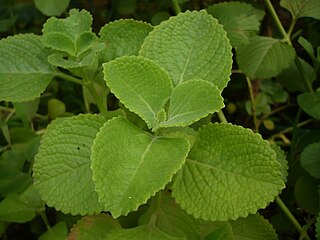
Coleus amboinicus, synonym Plectranthus amboinicus, is a semi-succulent perennial plant in the family Lamiaceae with a pungent oregano-like flavor and odor. Coleus amboinicus is considered to be native to parts of Africa, the Arabian Peninsula, and India, although it is widely cultivated and naturalized elsewhere in the tropics where it is used as a spice and ornamental plant. Common names in English include Indian borage, country borage, French thyme, Indian mint, Mexican mint, Cuban oregano, soup mint, Spanish thyme. The species epithet, amboinicus refers to Ambon Island, in Indonesia, where it was apparently encountered and described by João de Loureiro (1717–1791).
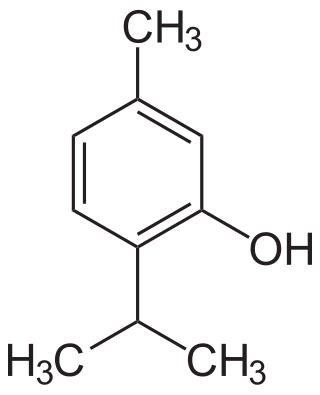
Thymol, C10H14O, is a natural monoterpenoid phenol derivative of p-Cymene, isomeric with carvacrol, found in oil of thyme, and extracted from Thymus vulgaris, ajwain, and various other plants as a white crystalline substance of a pleasant aromatic odor and strong antiseptic properties. Thymol also provides the distinctive, strong flavor of the culinary herb thyme, also produced from T. vulgaris. Thymol is only slightly soluble in water at neutral pH, but it is extremely soluble in alcohols and other organic solvents. It is also soluble in strongly alkaline aqueous solutions due to deprotonation of the phenol. Its dissociation constant (pKa) is 10.59±0.10. Thymol absorbs maximum UV radiation at 274 nm.

Monarda is a genus of flowering plants in the mint family, Lamiaceae. The genus is endemic to North America. Common names include bergamot, bee balm, horsemint, and oswego tea, the first being inspired by the fragrance of the leaves, which is reminiscent of bergamot orange. The genus was named for the Spanish botanist Nicolás Monardes, who wrote a book in 1574 describing plants of the New World.

Summer savory : is among the best known of the savory genus. It is an annual, but otherwise is similar in use and flavor to the perennial winter savory. It is used more often than winter savory, which has a slightly more bitter flavor.
Carvacrol, or cymophenol, C6H3(CH3)(OH)C3H7, is a monoterpenoid phenol. It has a characteristic pungent, warm odor of oregano.

α-Pinene is an organic compound of the terpene class. It is one of the two isomers of pinene, the other being β-pinene. An alkene, it contains a reactive four-membered ring. It is found in the oils of many species of many coniferous trees, notably the Pinus and Picea species. It is also found in the essential oil of rosemary and Satureja myrtifolia. Both enantiomers are known in nature; (1S,5S)- or (−)-α-pinene is more common in European pines, whereas the (1R,5R)- or (+)-α-isomer is more common in North America. The enantiomers' racemic mixture is present in some oils such as eucalyptus oil and orange peel oil.

Minthostachys is a genus of the mint family Lamiaceae, comprising aromatic scandent shrubs. It occurs along the Andes from Northern Venezuela through Colombia, Ecuador, Peru and Bolivia to Central Argentina.

Thymus pannonicus, known by its common name Hungarian thyme or Eurasian thyme, is a perennial herbaceous plant, distributed in central and eastern Europe and Russia. It grows over open dry meadows, grasslands, and rocks.
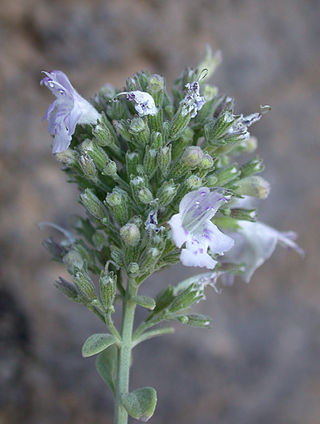
Micromeria fruticosa, commonly known as white micromeria or white-leaved savory, is a dwarf evergreen shrub endemic to the eastern Mediterranean, as well as found in the Balkans. It is a member of the genus Micromeria, in the family Lamiaceae. It is known as zuta levana in today's Modern Hebrew and ashab a-shai in Arabic. The Bedouins, however, call it by the Arabic name, qurniyya, believed to be a cognate of the Hebrew qoranit, an aromatic herb described in the Mishnah. The plant's aromatic leaves are used in making decoctions.
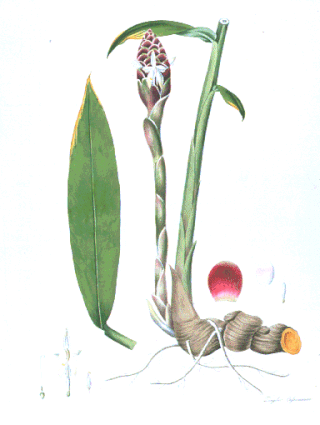
Cassumunar ginger: Zingiber cassumunar, now thought to be a synonym of Zingiber montanum (J.König) Link ex A.Dietr., is a species of plant in the ginger family and is also a relative of galangal. It is called plai (ไพล) in Thailand, in addition to in Isan language and in northern Thai language. The rhizome of variant 'Roxburgh' is used medicinally in massage and even in food in Thailand, and somewhat resembles ginger root or galangal. In aromatherapy, plai oil is used as an essential oil and is believed to ease pain and inflammation. It is also known as ponlei (ពន្លៃ) in Cambodia.
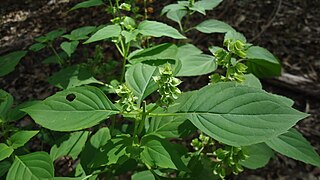
Ocimum campechianum is a plant species in the family Lamiaceae, widespread across Mexico, Central America, South America, the West Indies, and Florida.

Yerba buena or hierba buena is the Spanish name for a number of aromatic plants, most of which belong to the mint family. Yerba buena translates as "good herb". The specific plant species regarded as yerba buena varies from region to region, depending on what grows wild in the surrounding landscape, or which species is customarily grown in local gardens. Perhaps the most common variation of this plant is spearmint. The term has been used to cover a number of aromatic true mints and mint relatives of the genera Clinopodium, Satureja or Micromeria. All plants so named are associated with medicinal properties, and some have culinary value as herbal teas or seasonings as well.

Origanum onites, the Cretan oregano, Greek oregano, pot marjoram or Ellinikí rίgani in Greek, is a plant species in the genus Origanum found in Sicily, Greece and Turkey. It has similar flavors as common oregano.It has antimicrobial activities.

Thymus zygis is a type of flowering plant in the family Lamiaceae native to the Iberian Peninsula and northern Morocco.
Achillea santolina, a perennial herb, is commonly found in arid environments of Iraq and Jordan, but may colonize colder and more humid climates of the northern hemisphere, such as Europe and Asia. It is a traditional plant used as a herbal remedy in many parts of Iraq and Jordan and has been used as an insecticide and repellent.

Satureja thymbra, commonly known as savory of Crete, whorled savory, pink savory, and Roman hyssop, is a perennial-green dwarf shrub of the family Lamiaceae, having strongly scented leaves, endemic to Libya, southeastern Europe from Sardinia to Turkey; Cyprus, Lebanon and Israel (Palestine). The plant is noted for its dark-green leaves which grow on numerous, closely compacted branches, reaching a height of 20–50 cm. The plant bears pink to purple flowers that blossom between March and June.


















